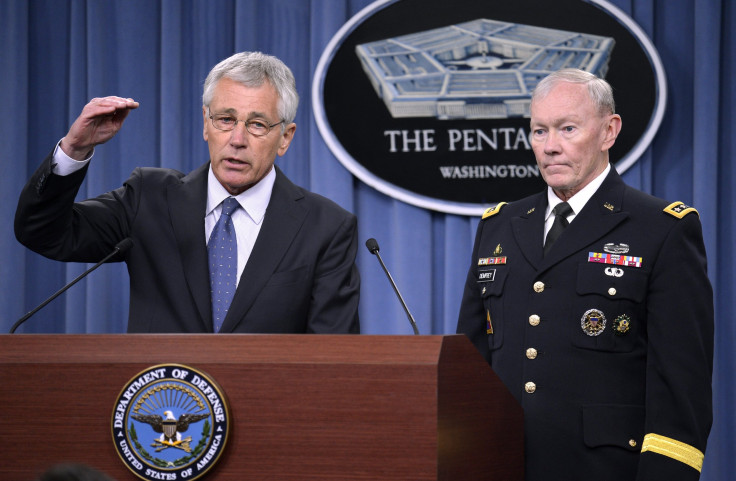The Pentagon Is About To Undergo These Major Budget Cuts

Defense Secretary Chuck Hagel on Monday outlined a five-year budget proposal that would reduce the size of the U.S. armed forces and slow the growth of military compensation in light of current fiscal constraints and calls for the Pentagon to get leaner.
After more than a decade of war, the Pentagon is shifting focus to its strategic challenges and future fiscal uncertainties. The proposed budget, said Hagel, will put the military in balance over the next decade and position it for those tests.
But the secretary assured Americans that even with the proposed force reduction the country will still be protected and President Barack Obama’s defense strategy will be fulfilled. Still, he admitted, this kind of tightening is a risky move, as for the near term there will continue to be maintenance and training gaps and the military’s ability to simultaneously respond to multiple emergencies will be affected.
“This is a time for reality,” Hagel said. “This is a budget that recognizes the reality of the magnitude of our fiscal challenges, the dangerous world we live in, and the American military’s unique and indispensable role in the security of this country and in today’s volatile world. There are difficult decisions ahead. That is the reality we’re living with.”
Here’s are some of the recommendations inside the DOD’s 2015 budget proposal by branches:
Air Force
A $1 billion investment in “next-generation” jet engine technology is recommended to achieve savings through a reduction in fuel consumption and maintenance. To pay for this the Air Force will:
-- Reduce the number of tactical air squadrons, including the entire A-10 fleet;
-- Retire the A-10 fleet, which will save $3.5 billion over five years. The A-10s will be replaced with the controversial F-35, which at approximately $400 billion for 2,400 planes is the nation’s most expensive weapons system;
-- Retire the 50-year-old U-2 in favor of the unmanned Global Hawk system after being able to reduce the Hawk’s operating cost;
-- Slow the growth of its armed unmanned systems and increase to 55 instead of 65 around-the-clock combat air patrols of Predator and Reaper aircraft; and
-- Implement more cuts if sequestration continues into 2016 by ridding itself of 80 more aircraft, including the entire KC-10 tanker fleet and the Global Hawk Block 40 fleet and slow down its Joint Strike Fighter purchasing. This could result in 24 fewer F-35s purchased through fiscal 2019.
Navy
-- Decide the future of the USS George Washington aircraft carrier if sequester levels are reinforced in 2016. It costs $6 billion to keep it in the fleet;
-- Begin no new contract negotiations for more than 32 Littoral Combat Ships in the future. Previous plans were to have 52 ships; and
-- Slow the rate of buying destroyers if sequestration further tightens spending;
Marine Corps
-- Shrink the number of Marines to 182,000 from 190,000;
-- Further decrease to about 175,000 pending sequester; and
-- Commit 900 additional Marines to embassies around the world.
Army
-- Reduce the active-duty Army to about 450,000 from 520,000 soldiers. This could go further to 420,000 depending on the sequester;
-- Terminate the Ground Combat Vehicle program and redirect funds to developing a next-generation platform;
-- Cut National Guard soldiers to 335,000 from 355,000 by 2017 and the Reserves to 195,000 from 205,000;
-- Transfer the Guard’s Apache attack helicopters to active-duty units; and
-- Transfer Army’s Blackhawk to the National Guard to improve disaster and emergency response capabilities.
Military Compensation
-- Recommend a 1 percent rise in basic pay for military personnel in fiscal 2015, except for general and flag officers. Their pay will be frozen for a year. Basic pay raises after that will be restrained;
-- Slow the growth of tax-free housing allowances. They currently cover 100 percent of housing expenses. That figure will be cut to an average of 95 percent of such expenses and the remaining 5 percent will be out-of-pocket contribution;
-- No longer reimburse for renter’s insurance;
-- Reduce by $1 billion the annual direct subsidy given to military commissaries over three years, which now totals $1.4 billion. Overseas commissaries and those in remote areas will continue to benefit from those subsidies;
-- Simplify and modernize the TRICARE health insurance program through consolidating plans and making adjustments to deductibles and co-pays; and
-- Ask retirees and some active-duty family members to come out of pocket a little in their deductibles and co-pays.
“A holistic and comprehensive approach must be taken to compensation changes,” Hagel said. “Continuous piecemeal changes will only magnify uncertainty and magnify doubts about our service members, with our service members, among our service members about whether promised benefits will be there in the future.”
Army Gen. Martin E. Dempsey, the chairman of the Joint Chiefs of Staff, signed off on Hagel’s budget, saying it “represents both sound national security and fiscal responsibility.”
“This budget helps us to remain the world’s finest military -- modern, capable and ready -- even while transitioning to a smaller more affordable force over time,” Dempsey said.
© Copyright IBTimes 2024. All rights reserved.






















